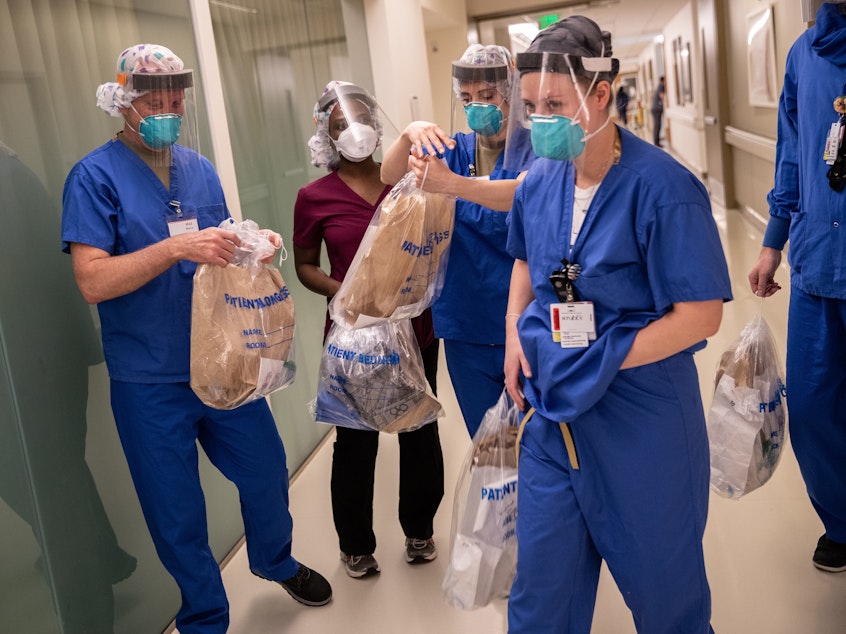Hospital ICUs Are Adapting To COVID-19 At 'Light Speed'

Intensive care teams inside hospitals are rapidly altering the way they care for patients with COVID-19.
The changes range from new protective gear to new treatment protocols aimed at preventing deadly blood clots.
"Things are moving so fast within this pandemic, it's hard to keep up" says Dr. Angela Hewlett, an infectious diseases physician at University of Nebraska Medical Center in Omaha and medical director of the Nebraska Biocontainment Unit. To stay current, she says, ICUs are updating their practices "on an hourly basis."
"We are learning at light speed about the disease," says Dr. Craig Coopersmith , interim director of the critical care center at Emory University. "Things that previously might have taken us years to learn, we're learning in a week or two. Things that might have taken us a month to learn beforehand, we're learning in a day or two."
The most obvious changes involve measures to protect ICU doctors, nurses and staff from the virus.
Sponsored
"There is a true and real probability of infection," says Dr. Tiffany Osborn a critical care specialist at Washington University School of Medicine and Barnes-Jewish Hospital in St. Louis. "You have to think about everything you touch as if it burned."
So ICUs are adapting measures used at special biocontainment units like the one at the University of Nebraska. These units were designed to care for patients affected by bioterrorism or infected with particularly hazardous communicable diseases like SARS and Ebola.
The Nebraska biocontainment unit "received several patients early on in the pandemic who were medically evacuated from the Diamond Princess cruise ship," Hewlett says. But it didn't have enough beds for the large numbers of local patients who began arriving at the University of Nebraska Medical Center.
So the nurses, respiratory therapists and physicians from the biocontainment team have "fanned out and are now working within those COVID units to make sure that all of our principles and protocols are followed there as well," Hewlett says.
Those protocols involve measures like monitoring ICU staff when they remove their protective gear to make sure the virus isn't transmitted, and placing infected patients in negative pressure rooms, which draw air inward, when possible to prevent the virus from escaping.
Sponsored
One of the riskiest ICU procedures is inserting a breathing tube in a COVID-19 patient's airway, which creates a direct path for virus to escape from a patient's lungs. "If you're intubating a patient, that's a much higher risk than, say, going in and doing routine patient care," Hewlett says.
So ICU teams are being advised to add several layers of protection beyond a surgical mask.
Extra personal protective equipment may include an N95 respirator, goggles, a full face shield, a head hood, an impermeable isolation gown and double gloves.
In many ICUs, teams are also placing a clear plastic box or sheet over the patient's head and upper body before inserting the tube. And as a final safety measure, the doctor may guide the tube using a video camera rather than looking directly down a patient's airway.
"It usually takes 30 minutes or so in order to get all of that equipment together, to get all of the right people there," says Dr. Kira Newman, a senior resident physician at UW Medical Center in Seattle. "and that would be a particularly fast intubation."
Sponsored
But most changes in the ICU are in response to an ongoing flood of new information about how COVID-19 affects the body.
There's a growing understanding, for example, that the infection can cause dangerous blood clots to form in many severely ill patients. These clots can kill if they block arteries supplying the lungs or brain. But they also can prevent blood from reaching the kidneys or even a patient's arms and legs.
Clots are a known risk for all ICU patients, Cooperman says, but the frequency and severity appears much greater with COVID-19. "So we're starting them on a higher level of medicine to prevent blood clots and if somebody actually develops blood clots, we have a plan B and a plan C and a plan D," he says.
ICU teams are also recalibrating their approach to ensuring that patients are getting enough oxygen. Early in the pandemic, the idea was to put patients on mechanical ventilator quickly to make sure their oxygen levels didn't fall too far.
But with experience, doctors have found that mechanical ventilators don't seem to work as well for COVID patients as they do for patients with other lung problems. They've also learned that that many COVID-19 patients remain lucid and relatively comfortable even when the oxygen levels in their blood are extremely low.
Sponsored
So many specialists are now recommending alternatives to mechanical ventilation, even for some of the sickest patients. "We're really trying now to not intubate," Osborn says.
Instead, ICU teams are relying on devices that deliver oxygen through the nasal passages, or through a mask that fits tightly over the face. And there's renewed interest in an old technique to help patients breathe. It's called proning.
"Instead of them being on their back, we're turning them on their front," Osborn says. The reason, she says is to open up a part of the lung that is collapsed when a patient is on their back. [Copyright 2020 NPR]



